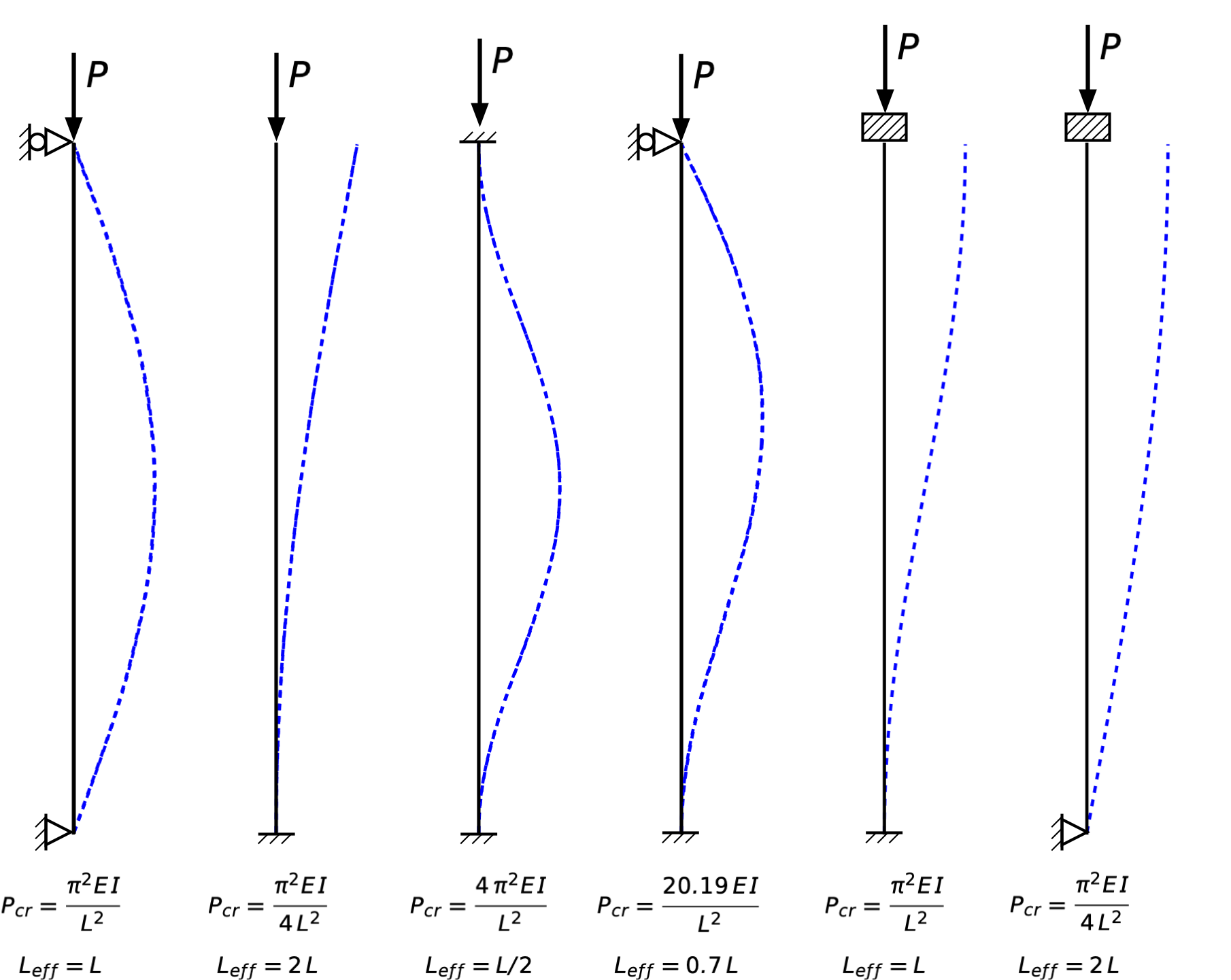Column buckling analysis
July 3, 2024 at 2:04 PM by Dr. Drang
Last time, we looked at the solutions for six elementary column buckling problems. In this post, we’ll outline the method for getting those solutions and give a couple of detailed examples.
In all of these problems, the column is assumed to be straight and prismatic, which means that the cross-section doesn’t change along its length. The minimum moment of inertia of the cross-section is , and the column buckles in the direction associated with .1 The column has a compressive load acting at either end, and the load is aligned with the centerline of the column. The material is linearly elastic with a Young’s modulus of , and there is no yielding of the material at any point.
With these assumptions the governing differential equation of the column is
where is the coordinate along the centerline of the column and is the (small) lateral deflection of the column when it buckles. This is a fourth-order linear differential equation with constant coefficients, which is great for us because it’s one of the few types of differential equation that can be solved analytically.
Here’s the general form of the solution,
where is a constant that combines the coefficients,
and , , , and are the four constants of integration that appear when solving a fourth-order differential equation. We’ll use the boundary conditions (how the column is supported at either end) to solve for these.
Simple-simple
The column with simple supports at either end is the fundamental problem of column buckling, and it’s pretty easy to work out its solution.

(I’m showing the column horizontally to take up less room on the screen. Because we’re not considering the weight of the column itself, the orientation doesn’t matter.)
We’ll start with the conditions at . Here, the column is prevented from moving laterally, so
or
The column is free to rotate at this end, which means there’s no bending moment. Since the bending moment is proportional to the second derivative of the deflection,
where I’m using the prime notation for derivatives. This means and therefore , which simplifies things nicely.
Now we look at the other end, , where again the lateral defection is zero,
and the bending moment is zero,
Since isn’t zero, the second equation means
and combining that with the first equation tells us that .
So we’ve eliminated all the constants of integration except . The equation above means either
or
The first of these is the solution when the column is straight and throughout its length. It is a solution, but it’s trivial—we know the column can be straight if the load is small.2 We’re interested in the nontrivial solution for which the column isn’t straight. That’s the buckling solution.
So when does ? When , for any integer . The buckling load will be when is the smallest positive value that satisfies this equation. In other words,
or
which is the answer we saw in the last post for the simple-simple column.
What about ? Well, is undetermined. Remember at the top of the post where I snuck the parenthetical “(small)” into the description of and didn’t explain it? Here’s where that comes in. Buckling deflections really aren’t small, and to solve for them properly we’d have to start with a nonlinear differential equation. But that doesn’t mean what we’ve done is useless. The value of is correct, and what we’ve done tells us that the deflected shape of the buckled column,
is one-half of a sine wave. This is useful because it helps us visualize the buckling.
Fixed-simple
This is the problem that inspired the previous post. It won’t take as long because we can use some of the simple-simple results to speed things up.

Again, we start with the general solution,
The boundary conditions at are the same as before,3 so we know that
The boundary conditions at are partly the same and partly different. The deflection is zero,
and the slope is zero,
The slope condition means
Substituting this into the deflection boundary condition gives
or
Once again, there’s the trivial solution, , and the nontrivial solution,
Divide this through by and move one term to the other side of the equation to get
As we saw in the previous post, the smallest positive solution is
and therefore
Once again, we can’t solve for , but we can see that the buckled shape is
which isn’t any sort of standard trig function, but it is what I plotted for the fourth column in this image:

All the other column problems in the image above can be solved the same way. The boundary conditions are different, but the solution process is the same. Notice that all the columns other than the fixed-simple buckle into shapes that are portions of sine waves. As we showed above, the simple-simple column is half of a sine wave. As for the others:
- The fixed-free column is a quarter of a sine wave.
- The fixed-fixed column is a full sine wave.
- The fixed-guided column is half of a sine wave.
- The simple-guided column is a quarter of a sine wave.
The effective length is based on the number of half sine waves the buckled shape has.
This simple visualization of the buckled shapes allows you to work out the buckling loads for all four of these columns based on the simple-simple column. The only other thing you have to remember is 4.49.
